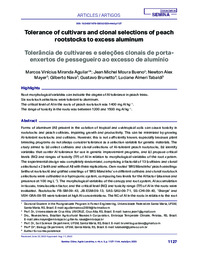Tolerance of cultivars and clonal selections of peach rootstocks to excess aluminum.
Tolerance of cultivars and clonal selections of peach rootstocks to excess aluminum.
Autoria: AGUILAR, M. V. M.; BUENO, J. M. M.; MAYER, N. A.; NAVA, G.; BRUNETTO, G.; TABALDI, L. A.
Resumo: Forms of aluminum (Al) present in the solution of tropical and subtropical soils can cause toxicity in rootstocks and peach cultivars, impairing growth and productivity. This can be minimized by growing Al-tolerant rootstocks and cultivars. However, this is not sufficiently known, especially because plant breeding programs do not always consider tolerance as a selection variable for genetic materials. The study aimed to (a) select cultivars and clonal selections of Al-tolerant peach rootstocks, (b) identify variables that confer Al tolerance for use in genetic improvement programs, and (c) propose critical levels (NC) and ranges of toxicity (TF) of Al in relation to morphological variables of the root system. The experimental design was completely randomized, comprising a factorial of 13 (cultivars and clonal selections) x 2 (with and without Al) with three replications. Own-rooted ?BRS Mandinho? peach seedlings (without rootstock) and grafted seedlings of ?BRS Mandinho? on different cultivars and clonal rootstock selections were cultivated in a hydroponic system, composing two levels for the Al factor (absence and presence at 100 mg L?1). The morphological variables of the canopy and root system, Al accumulation in tissues, translocation factor, and the critical level (NC) and toxicity range (TF) of Al in the roots were evaluated. Rootstocks FB-SM-09-43, JB-ESM-09-13, SAS-SAU-09-71, SS-CHI-09-40, ?Sharpe? and VEH-GRA-09-55 were tolerant at high Al concentrations. The NC of Al in the roots in relation to the root surface area of peach rootstocks was 1400 mg Al kg?1, and the FT was between 1200 and 1500 mg Al kg?1.
Ano de publicação: 2023
Tipo de publicação: Artigo de periódico
Unidade: Embrapa Clima Temperado
Palavras-chave: Alumínio, Porta Enxerto, Pêssego, Toxicologia
Observações
1 - Por padrão são exibidas publicações dos últimos 20 anos. Para encontrar publicações mais antigas, configure o filtro ano de publicação, colocando o ano a partir do qual você deseja encontrar publicações. O filtro está na coluna da esquerda na busca acima.
2 - Para ler algumas publicações da Embrapa (apenas as que estão em formato ePub), é necessário ter, no celular ou computador, um desses softwares gratuitos. Sistemas Android: Google Play Livros; IOS: iBooks; Windows e Linux: software Calibre.
Acesse outras publicações
Acesse a Base de Dados da Pesquisa Agropecuária (BDPA) para consultar o acervo completo das bibliotecas da Embrapa.

